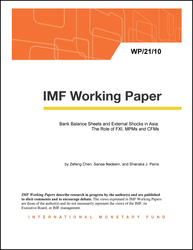
Bank Balance Sheets and External Shocks in Asia: The Role of FXI, MPMs and CFMs
Bank Balance Sheets and External Shocks in Asia: The Role of FXI, MPMs and CFMs
READ MORE...
Volume/Issue:
Volume 2021
Issue 010
Publication date: January 2021
ISBN: 9781513566832
$18.00
Add to Cart by clicking price of the language and format you'd like to purchase
Available Languages and Formats
| English |
Prices in red indicate formats that are not yet available but are forthcoming.
Topics covered in this book
This title contains information about the following subjects.
Click on a subject if you would like to see other titles with the same subjects.
Exports and Imports , bank balance sheets , foreign exchange intervention , macroprudential policy , capital flows measures , WP , capital account liberalization , FDI inflow , FDI decision , FDI liberalization , interest rate , bank balance balance sheet , FX liability , banking sector , exchange rate depreciation
Summary
In emerging Asia, banks constitute the dominant source of financing consumption and investment, and bank balance sheets comprise large gross FX assets and liabilities. This paper extends the DSGE model of Gertler and Karadi (2011) to incorporate these key features and estimates a panel vector autoregression on ten Asian economies to understand the role of the banking sector in transmitting spillovers from the global financial cycle to small open economies. It also evaluates the effectiveness of foreign exchange intervention (FXI) and other macroeconomic policies in responding to external financing shocks. External financial shocks affect net external liabilities of banks and the exchange rate, leading to changes in credit supply by banks and investment. For example, a capital outflow shock leads to a deprecation that reduces the net worth and intermediation capacity of banks exposed to foreign currency liabilities. In such cases, the exchange rate acts as shock amplifier and sterilized FXI, often deployed by Asian economies, can help cushion the economy. By contrast, with real shocks, the exchange rate serves as a shock absorber, and any FXI that weakens that function can be costly. We also explore the effectiveness of the monetary policy interest rate, macroprudential policies (MPMs) and capital flow management measures (CFMs).
Copyright © 2010 - 2025
Powered by:
AIDC



